Rock-Breaking Properties of Multi-Nozzle Bits for Tree-Type Drilling in Underground Coal Mines
Abstract
:1. Introduction
2. Analysis of the Rock-Breaking Capacity of Multi-Nozzle Bits
2.1. The Analysis of Rock-Breaking Velocity of Multi-Nozzle Bits
2.2. The Analysis of the Diameter of a Borehole Formed by a Multi-Nozzle Bit
3. Materials and Methods
3.1. Parameters of the Multi-Nozzle Bit
3.2. Experimental Apparatus and Procedures
- a)
- High-pressure pump. This is a high-performance pump manufactured in the United States with a peak pressure of 134 MPa and a flow rate of 104 L/min.
- b)
- Test control system. For monitoring the pressure and flow at all times during the experiment, a system for pressure and flow control was designed. It consists of a pressure transmitter, an outer clamping-type ultrasonic flowmeter, a data storage system, and data process and analysis software. The system is capable of testing pressures of 0–70 MPa with ±0.1% precision. The flowmeter can accurately record flows of 0.5–20 m/s ± 1%.
- c)
- Water jet test system. This system is made up of a drilling console with a sample (rock) holder and rock bearing system. A steel pipe is fixed to the drilling console. The console plus pipe can be advanced at a controlled rate of between 0.01 mm/s and 100 mm/s with the front end of the pipe connected to the multi-nozzle bit. A pressure gauge on the steel pipe monitors the inlet pressure to the bit. The rock bearing system that holds the rock sample can move up and down, forward and backward.
- d)
- Rock sample. Because coal is very anisotropic and commonly has abundant joints and fissures, a block of coal impacted by a water jet splits easily. This makes experiments fail; blocks of coal are not really suitable for drilling experiments. Therefore, to better evaluate rock-breaking efficiency and observe the shape of the borehole, artificial rock samples with good homogeneity were used instead of coal samples for these experiments. The samples were concrete, 30 cm × 30 cm × 30 cm in size with a sand:cement ratio of 3.37:1. The samples had a uniaxial compressive strength of 20 MPa.
- e)
- f)
- Evaluation indexes. The depth, diameter, and volume of the borehole are regarded as the best indexes for evaluating rock-breaking efficiency [18,26,27]. Because the hydraulic parameters (jet pressure, drilling time and standoff distance) are all fixed, thus the rock-breaking efficiency was evaluated by volume, diameter and depth of borehole per unit time of drilling with a fixed jet pressure and standoff distance. In Section 4.2.4, the roundness of borehole was also adopted through qualitative analysis. Depth is defined as the distance from the sample surface to the deepest portion of the borehole. Diameter is measured where the borehole is narrowest because the diameter of the narrowest part of the hole determines whether a multi-nozzle bit can pass through the sub-borehole. Volume is measured after drilling is completed by the sand replacement method. The data discussed later in this paper are the mean values from three holes drilled with each multi-nozzle bit under the same experimental conditions.
4. Results and Discussion
4.1. Analysis of the Influence of the Parameters of the Bit on Rock-Breaking Efficiency
4.2. Analysis of the Effect of Structural Parameters on Rock-Breaking Efficiency
4.2.1. Effect of Forward Nozzle Diameter on Rocking-Breaking Efficiency
4.2.2. Effect of Forward Nozzle Radial Angle on Rocking-Breaking Efficiency
4.2.3. Effect of Forward Nozzle Axial Angle on Rocking-Breaking Efficiency
4.2.4. Effect of the Number of Forward Nozzles on Rocking-Breaking Efficiency
4.2.5. Effect of Forward Nozzle Arrangement Distance on Rocking-Breaking Efficiency
4.3. Regression Analysis of Experimental Results
5. Conclusions
Acknowledgments
Author Contributions
Conflicts of Interest
References
- Sun, M.Y. CBM, a nascent new energy. Sci. Technol. Rev. 1996, 8, 59–61. [Google Scholar]
- Hu, G.Z.; Huang, X.; Xu, J.L.; Qin, W.; Wang, H.T. A co-extraction technology of coal and CBM based on the law of gas advanced relieving pressure of in-seam coalface. Disaster Adv. 2012, 5, 1351–1356. [Google Scholar]
- Dai, J.X.; Ni, Y.Y.; Wu, X.Q. Tight gas in China and its significance in exploration and exploitation. Pet. Explo. Dev. 2012, 39, 277–284. [Google Scholar] [CrossRef]
- Bibler, C.J.; Marshall, J.S.; Pilcher, R.C. Status of worldwide coal mine methane emissions and use. Int. J. Coal Geol. 1998, 35, 283–310. [Google Scholar] [CrossRef]
- Hu, G.Z.; Xu, J.L.; Zhang, F.X.; Zhao, C.C.; Qin, W.; Zhu, Y.R. Coal and coalbed methane co-extraction technology based on the ground movement in the Yangquan coalfield, China. Energies 2015, 8, 6881–6897. [Google Scholar] [CrossRef]
- Lin, B.Q.; Liu, T.; Zhou, Y.; Zhang, Z.; Yan, F.Z. Variation of methane adsorption property of coal after the treatment of hydraulic slotting and methane pre-drainage: A case study. J. Nat. Gas Sci. Eng. 2014, 20, 396–406. [Google Scholar]
- Qian, M.G.; Miao, X.X.; Xu, J.L. Resources and environment harmonics (green) mining and its technological system. J. Min. Saf. Eng. 2006, 23, 1–5. [Google Scholar]
- Noack, K. Control of gas emissions in underground coal mines. Int. J. Coal Geol. 1998, 35, 57–82. [Google Scholar] [CrossRef]
- Shen, B.H.; Liu, J.Z.; Zhang, H. The technical measures of gas control in China coal mines. J. China Coal Soc. 2007, 32, 673–679. [Google Scholar]
- Lu, T.K.; Yu, H.; Zhou, T.Y.; Mao, J.S.; Guo, B.H. Improvement of methane drainage in high gassy coal seam using waterjet technique. Int. J. Coal Geol. 2009, 79, 40–48. [Google Scholar] [CrossRef]
- Lu, Y.Y.; Liu, Y.; Li, X.H.; Kang, Y. A new method of drilling long boreholes in low permeability coal by improving its permeability. Int. J. Coal Geol. 2010, 84, 94–102. [Google Scholar] [CrossRef]
- Yuan, L.; Lin, B.; Yang, W. Research progress and development direction of gas control with mine hydraulic technology in China coal mine. Coal Sci. Technol. 2015, 43, 45–49. [Google Scholar]
- Wang, Y.F.; He, X.Q.; Wang, E.Y. Research progress and development tendency of the hydraulic technology for increasing the permeabilityof coal seams. J. China Coal Soc. 2014, 39, 1945–1955. [Google Scholar]
- Lu, Y.Y.; Zhou, Z.; Ge, Z.L.; Zhang, X.W.; Li, Q. Research on and design of a self-propelled nozzle for the tree-type drilling technique in underground coal mines. Energies 2015, 8, 14260–14271. [Google Scholar] [CrossRef]
- Ma, D.J.; Li, G.S.; Niu, J.L.; Liao, H.L.; Huang, Z.W. Experimental study on rock breaking and drilling laws by multi-hole jet bit. Fluid Mach. 2015, 43, 1–5. [Google Scholar]
- Buset, P.; Riiber, M.; Eek, A. Jet Drilling Tool: Cost-Effective Lateral Drilling Technology for Enhanced Oil Recovery. In Proceedings of the SPE/ICoTA Coiled Tubing Roundtable, Houston, TX, USA, 7–8 March 2001.
- Buckman, W.G., Sr. Method and Apparatus for Jet Drilling Drainholes from Wells. U.S. Patent 6,263,984 B1, 24 July 2001. [Google Scholar]
- Liao, H.L.; Niu, J.L.; Cheng, Y.X.; Huang, Z.W.; Ma, D.J. Experiment study on water jet breaking rock by multi-orifice nozzle. J. China Coal Soc. 2011, 36, 1858–1862. [Google Scholar]
- Ma, D.J.; Li, G.S.; Huang, Z.W.; Li, J.B.; Wang, J.L. Mechanism of a self-propelled multi-hole jet bit and influencing rules on its self-propelled force. Nat. Gas Indus. 2014, 34, 99–104. [Google Scholar]
- Di, F.; Li, G.S.; Huang, Z.W.; Song, X.Z.; Chi, H.P. Capability analysis of self-feeding multi-nozzle jet bit in radial horizontal drilling. China Pet Mach. 2014, 42, 7–11. [Google Scholar]
- Li, J.B.; Li, G.S.; Huang, Z.W.; Song, X.Z.; Yang, R.R.; Peng, K.W. The self-propelled force model of a multi-orifice nozzle for radial jet drilling. J. Nat Gas Sci. Eng. 2015, 24, 441–448. [Google Scholar] [CrossRef]
- Hu, K.; Peng, X.; Li, J.; Hu, B.W.; Ai, Z.J. Simulation based on the CFD of self-propulsion nozzle’s flow field. J. Southwest Pet. Univ. Sci. Technol. Ed. 2013, 35, 159–165. [Google Scholar]
- Liu, C.; Wu, Z.H.; Zhang, J.J. Fluid-structure interaction analysis of radial hole drilling jet nozzle in rock breaking. Oil Field Equip. 2015, 44, 10–14. [Google Scholar]
- Zhou, Y.X. The Experiment Design and Data Processing; Hubei Science and Technology Press: Wuhan, China, 2005; pp. 113–138. [Google Scholar]
- Chi, H.P.; Li, G.S.; Liao, H.L.; Huang, Z.W.; Song, X.Z.; Di, F.; Tang, G.W. Experimental research on optimum of jetting bit in radial drilling by hydra-jet. Fluid Mach. 2013, 41, 1–6. [Google Scholar]
- Ma, D.J.; Li, G.S.; Zhang, X.N.; Huang, Z.W. Experimental study on rock breaking by a combined round straight jet with a swirling jet nozzle. At. Sprays 2011, 21, 645–653. [Google Scholar] [CrossRef]
- Liao, H.L.; Li, G.S.; Niu, J.L.; Huang, Z.W. Integrating straight & swirling jets bit design and its rock breaking characteristics for radial horizontal hole drilling. J. China Coal Soc. 2013, 38, 424–429. [Google Scholar]
- Labus, T.J. Fluid Jet Technology: Fundamentals and Application; Water Jet Technology Association: St. Louis, MO, USA, 1995. [Google Scholar]
- Chen, T.G.; Guan, Z.C. Theory and Technology of Drilling Engineering; China University of Petroleum Press: Dongying, China, 2006; pp. 148–154. [Google Scholar]
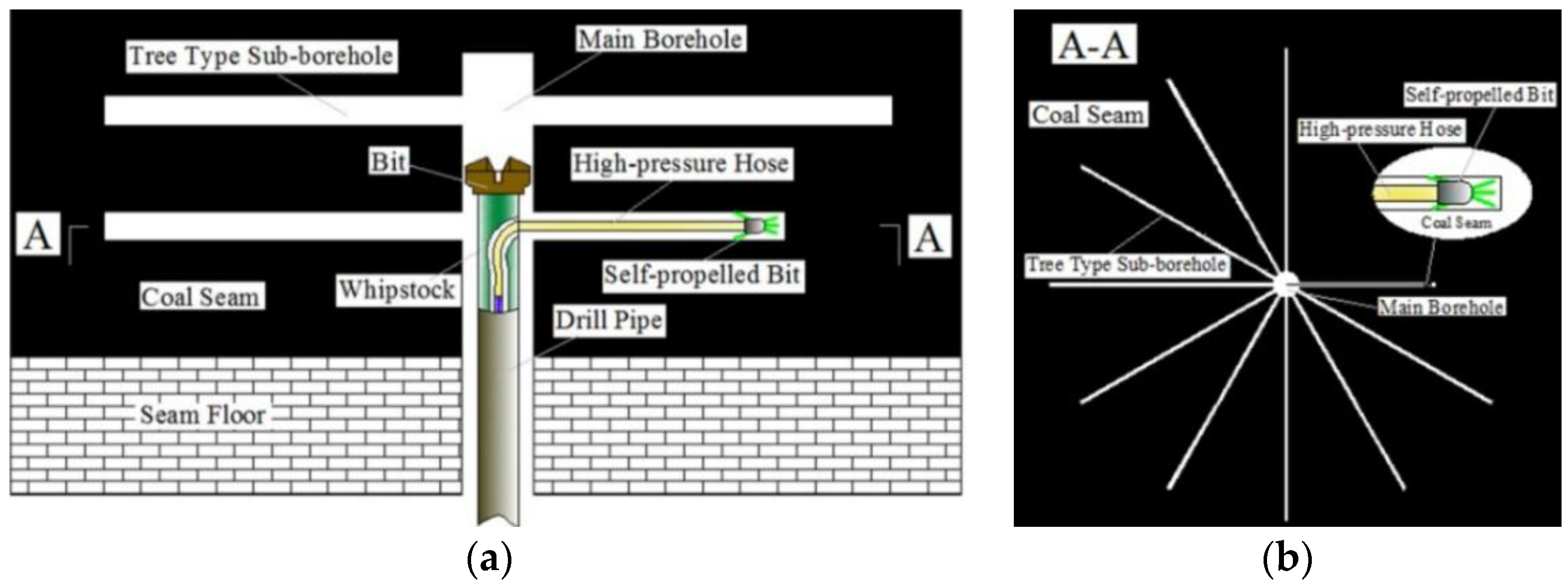
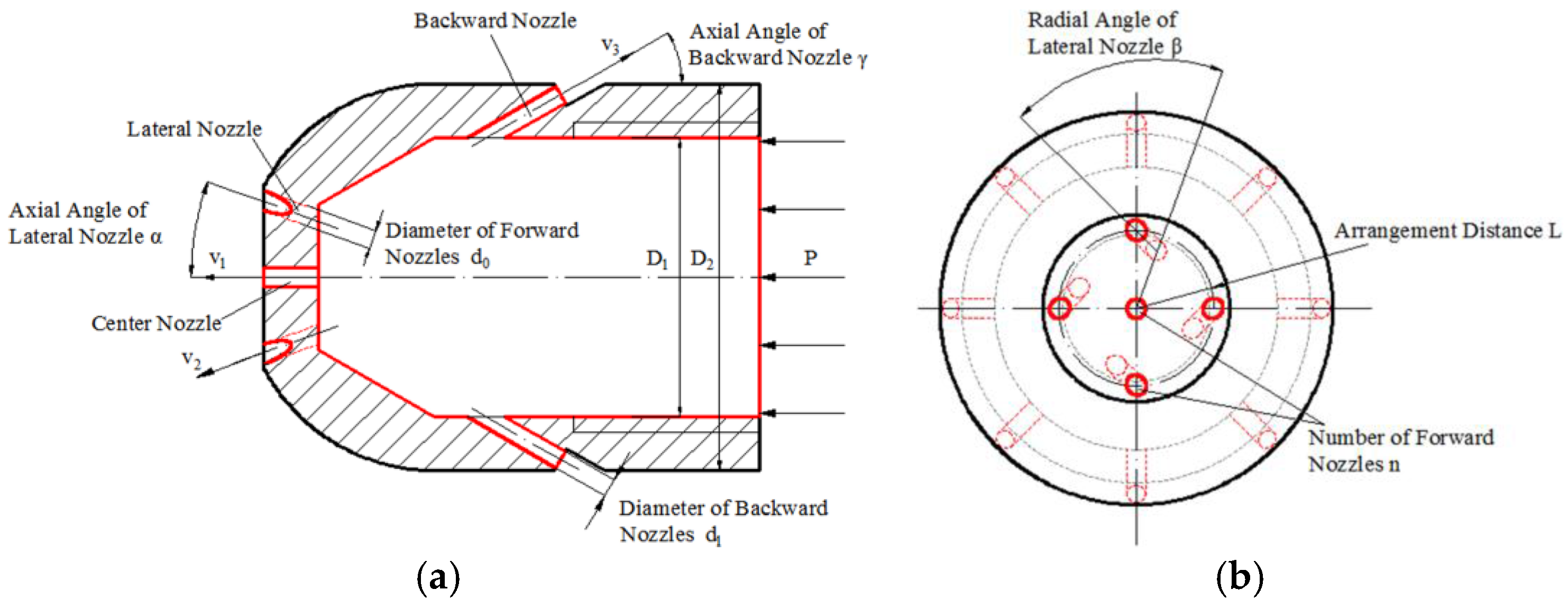
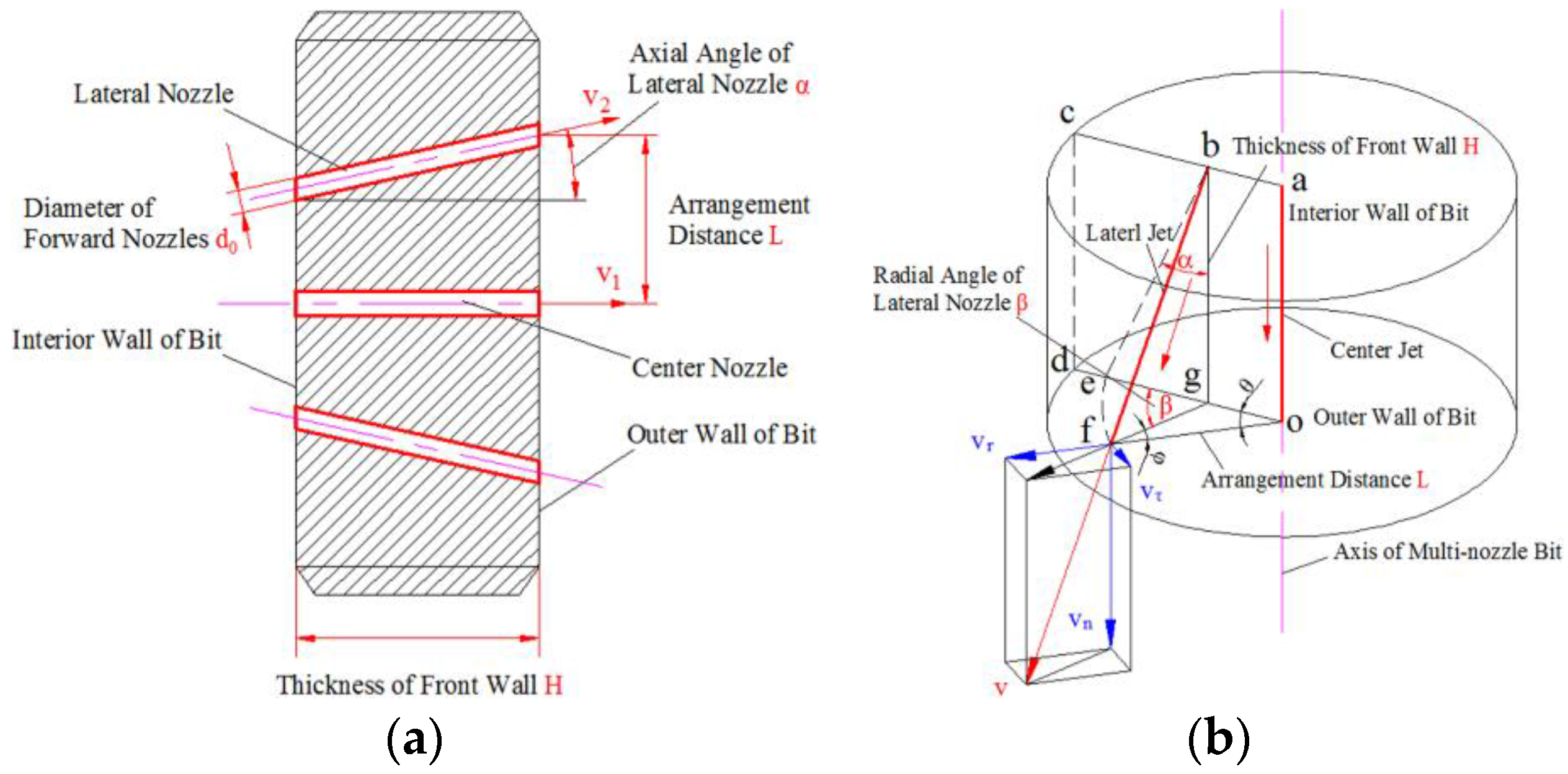

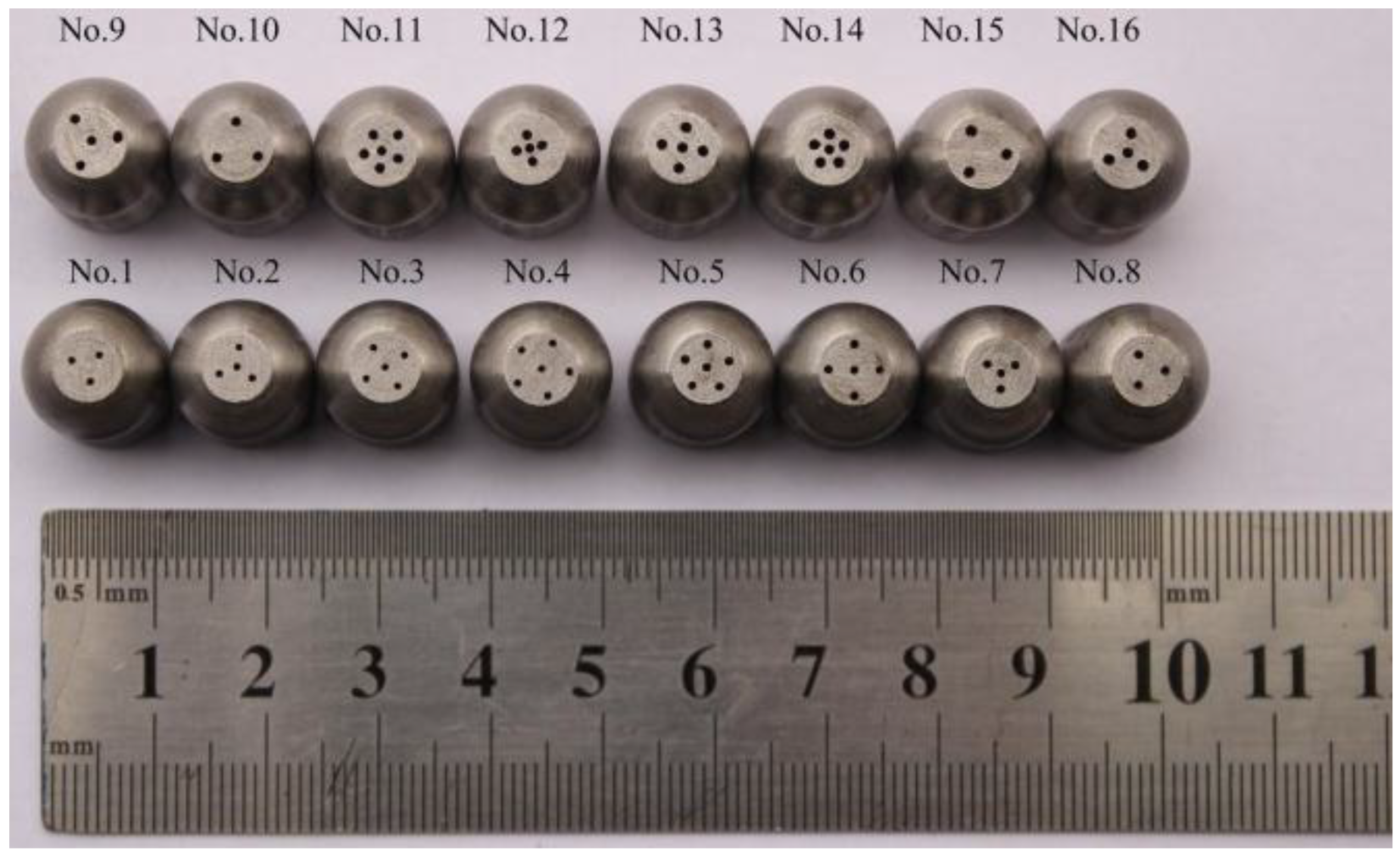
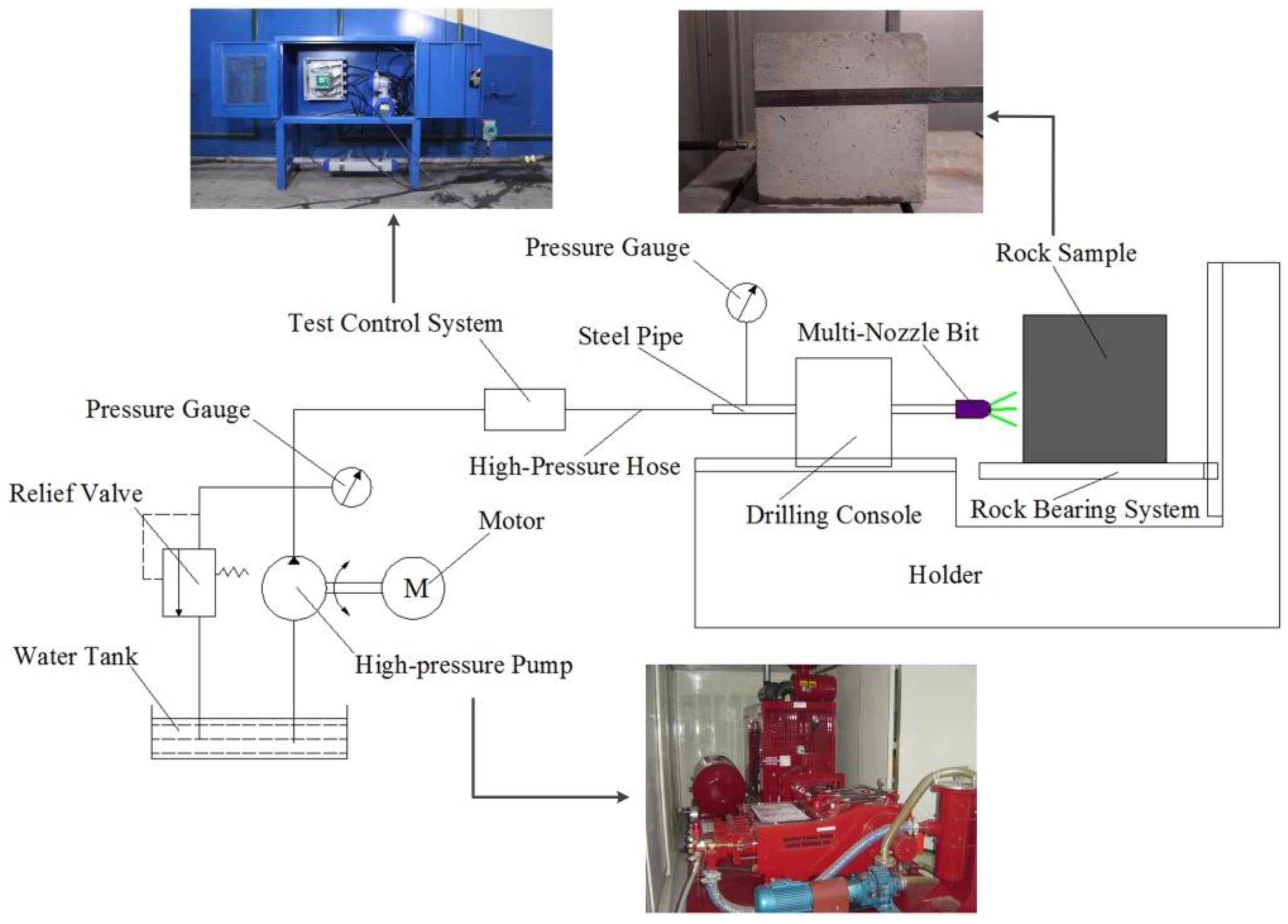
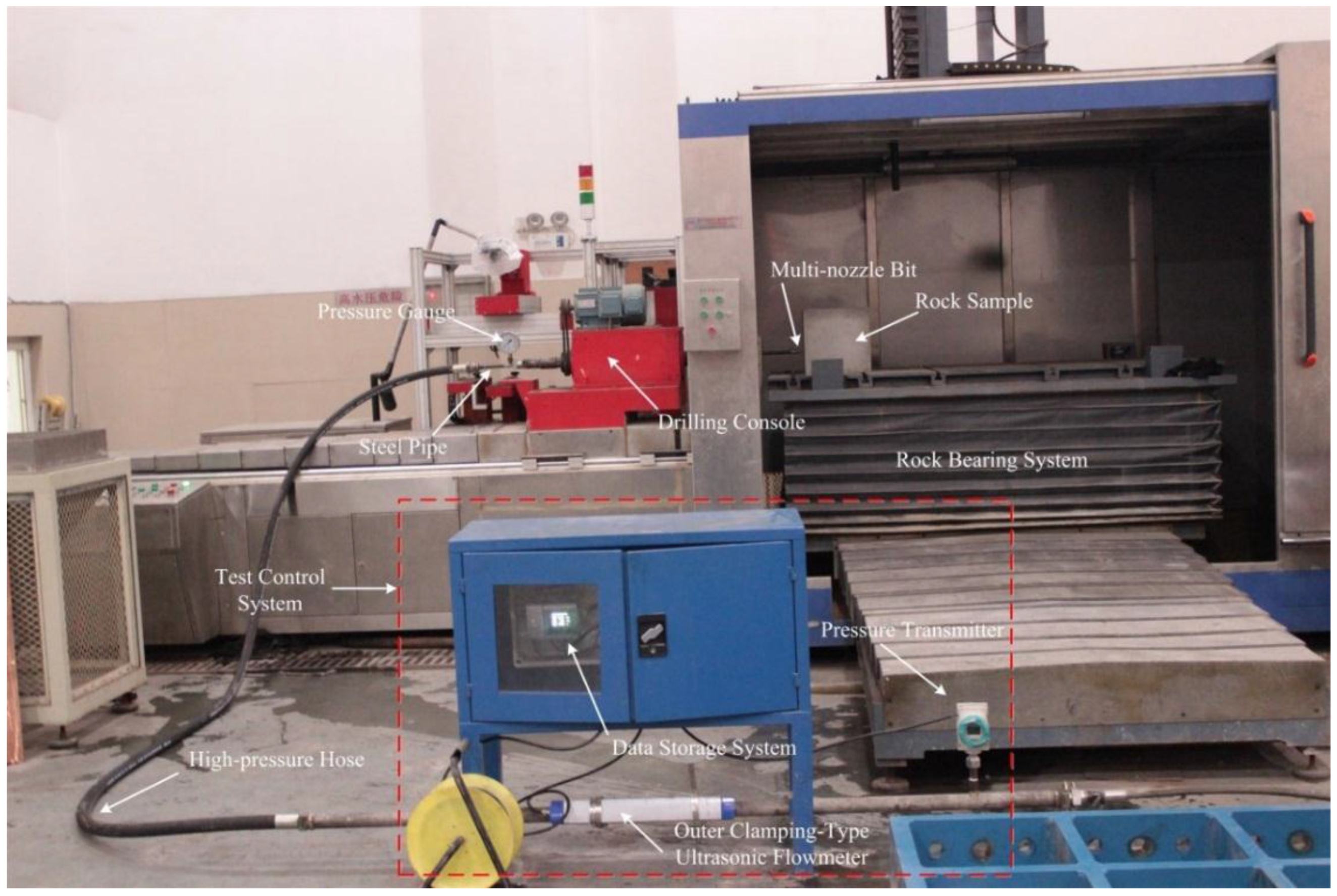
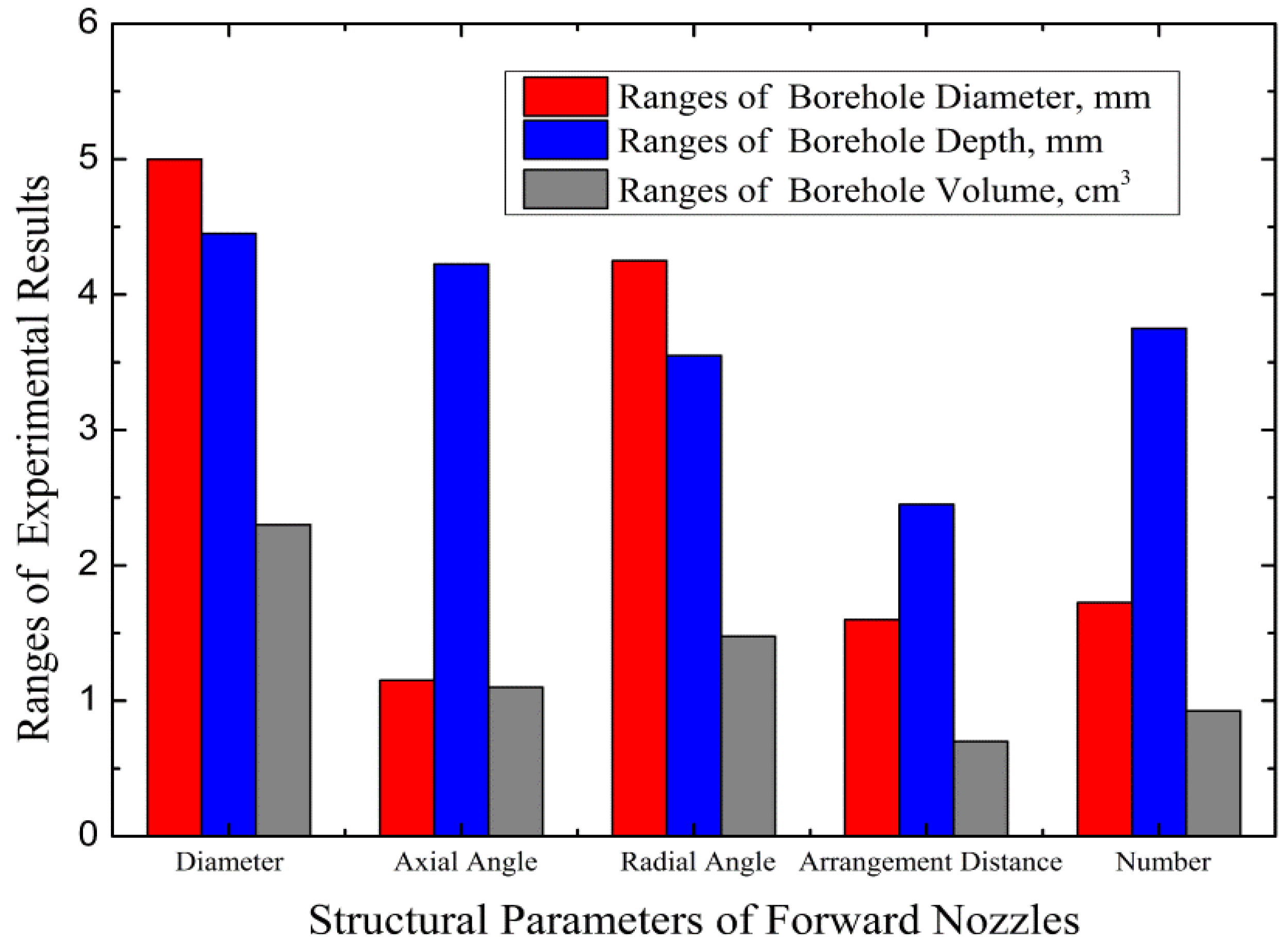
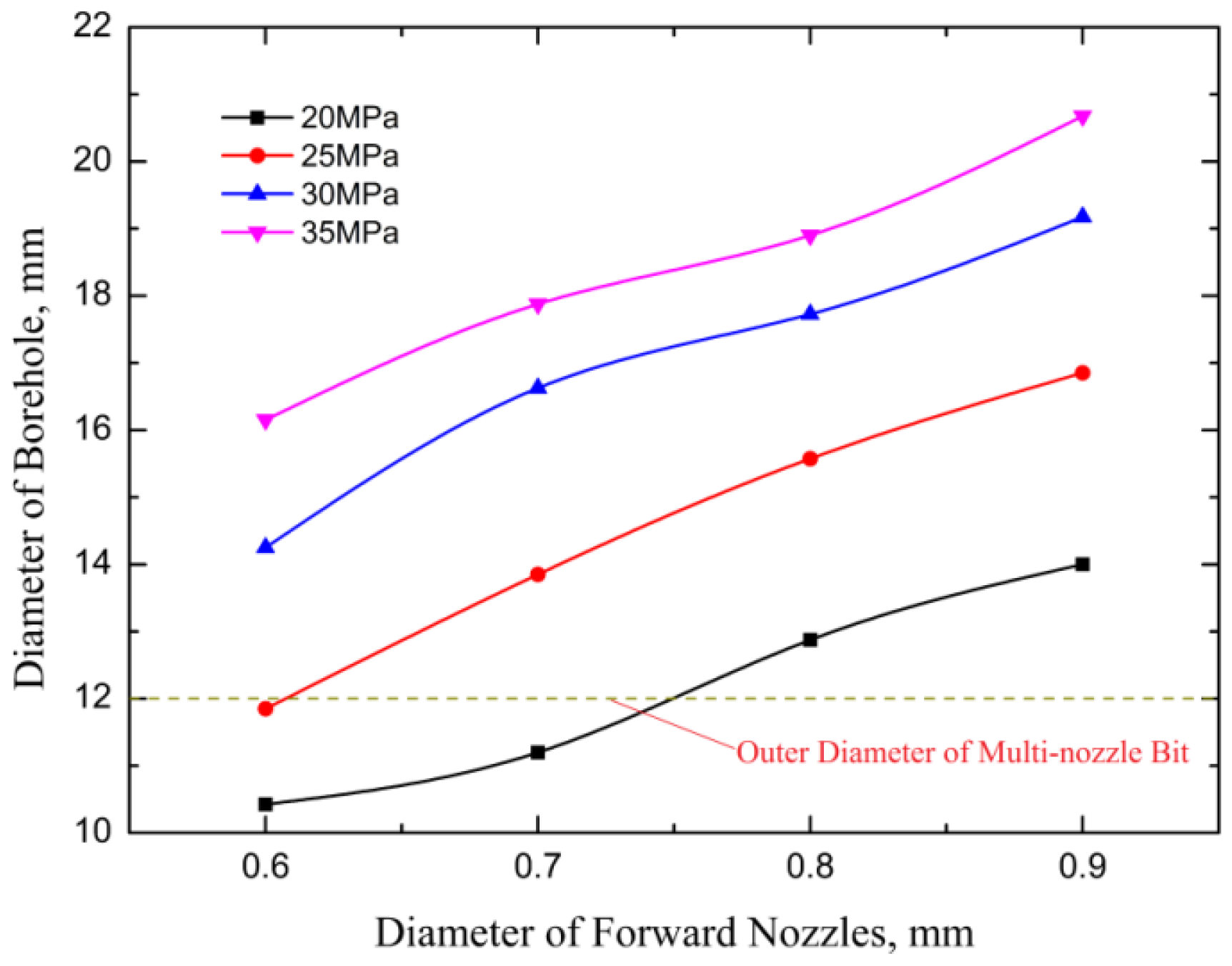
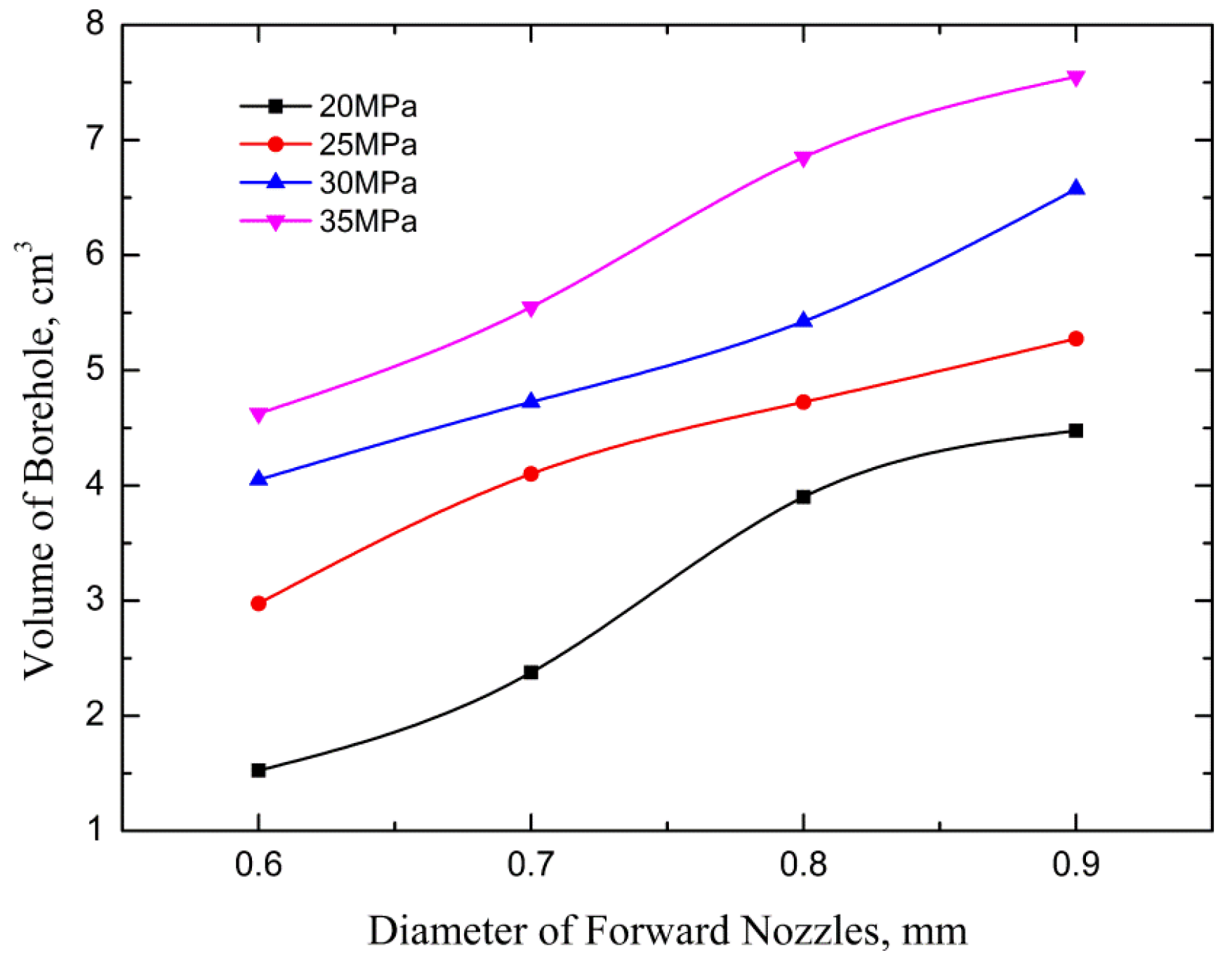
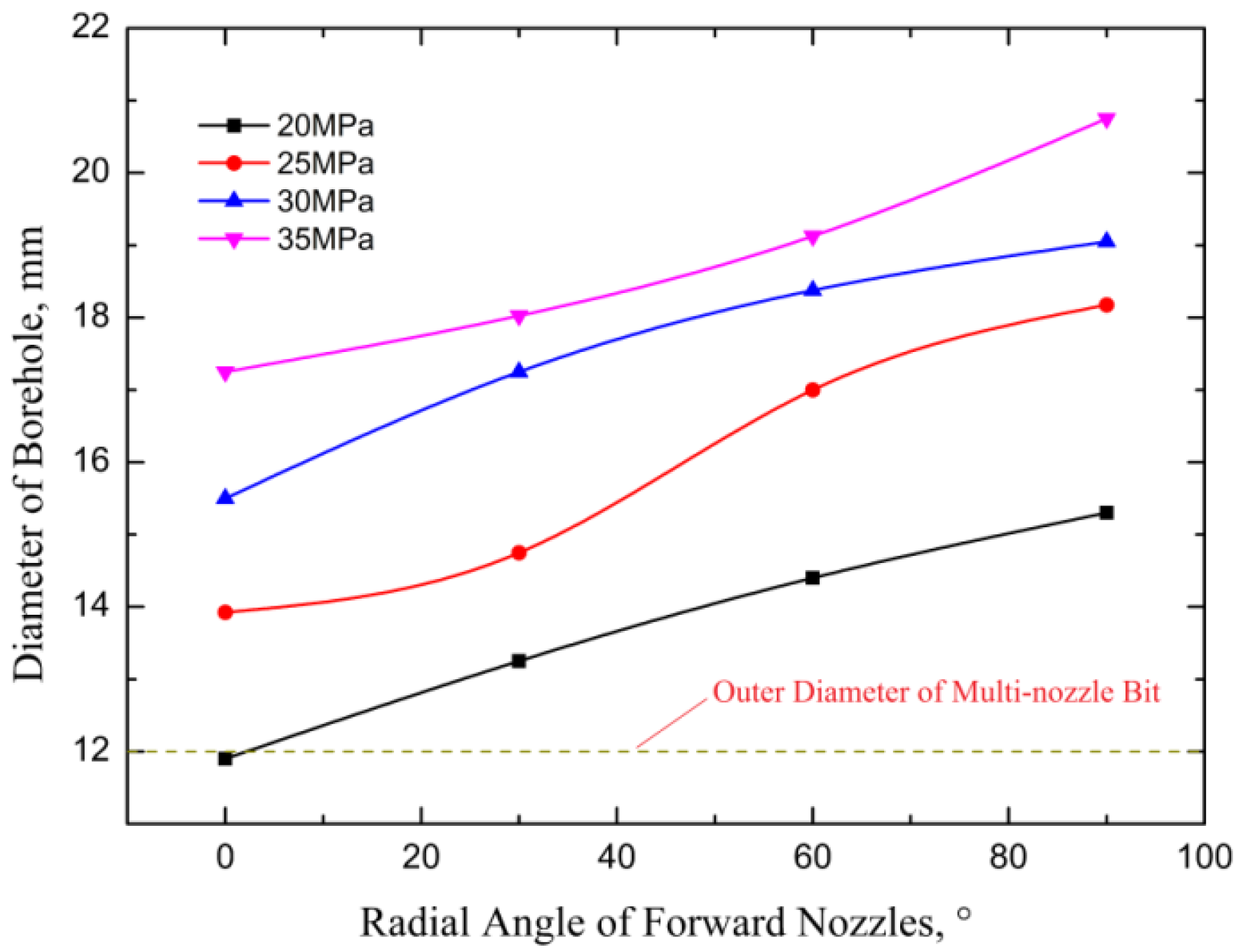
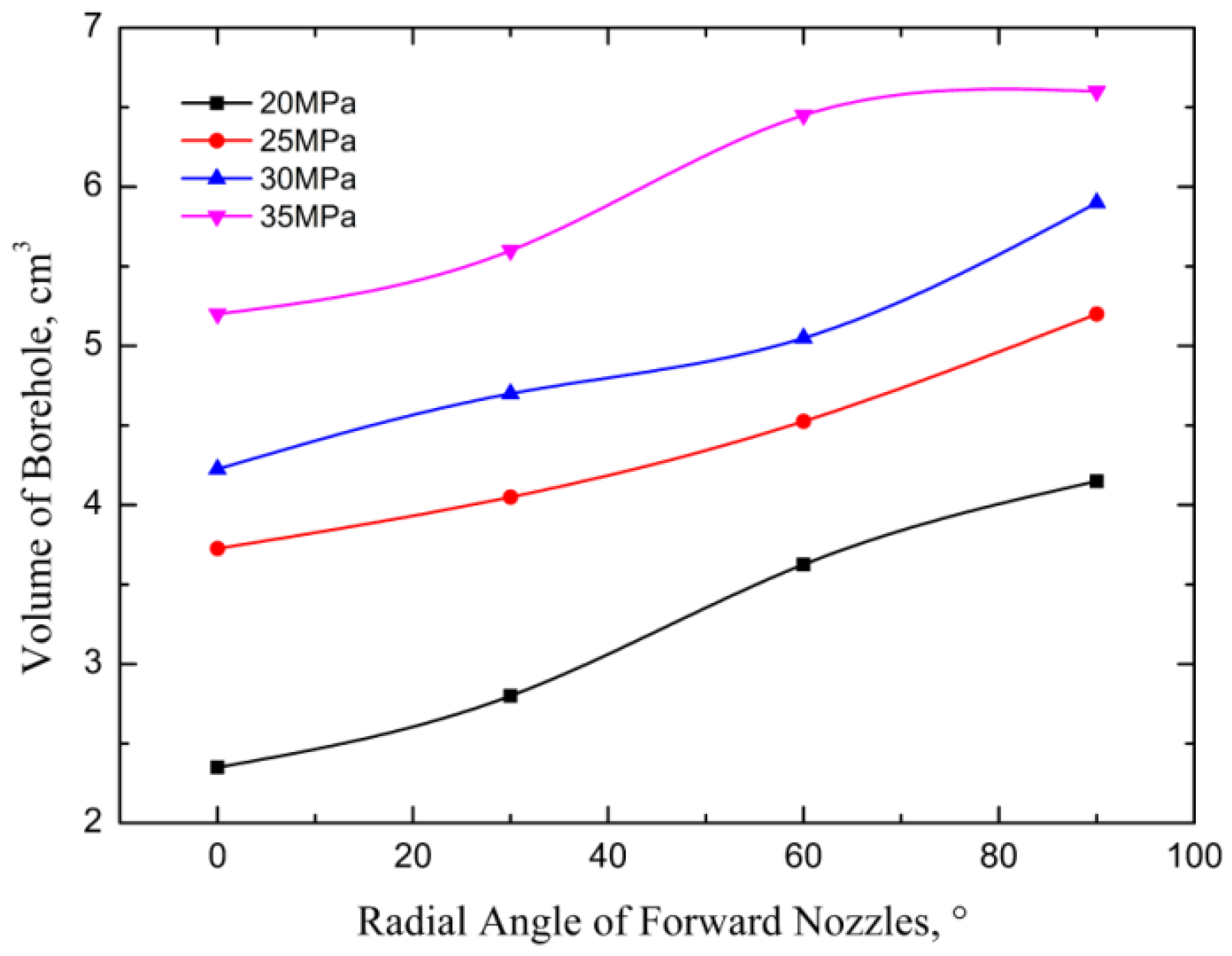

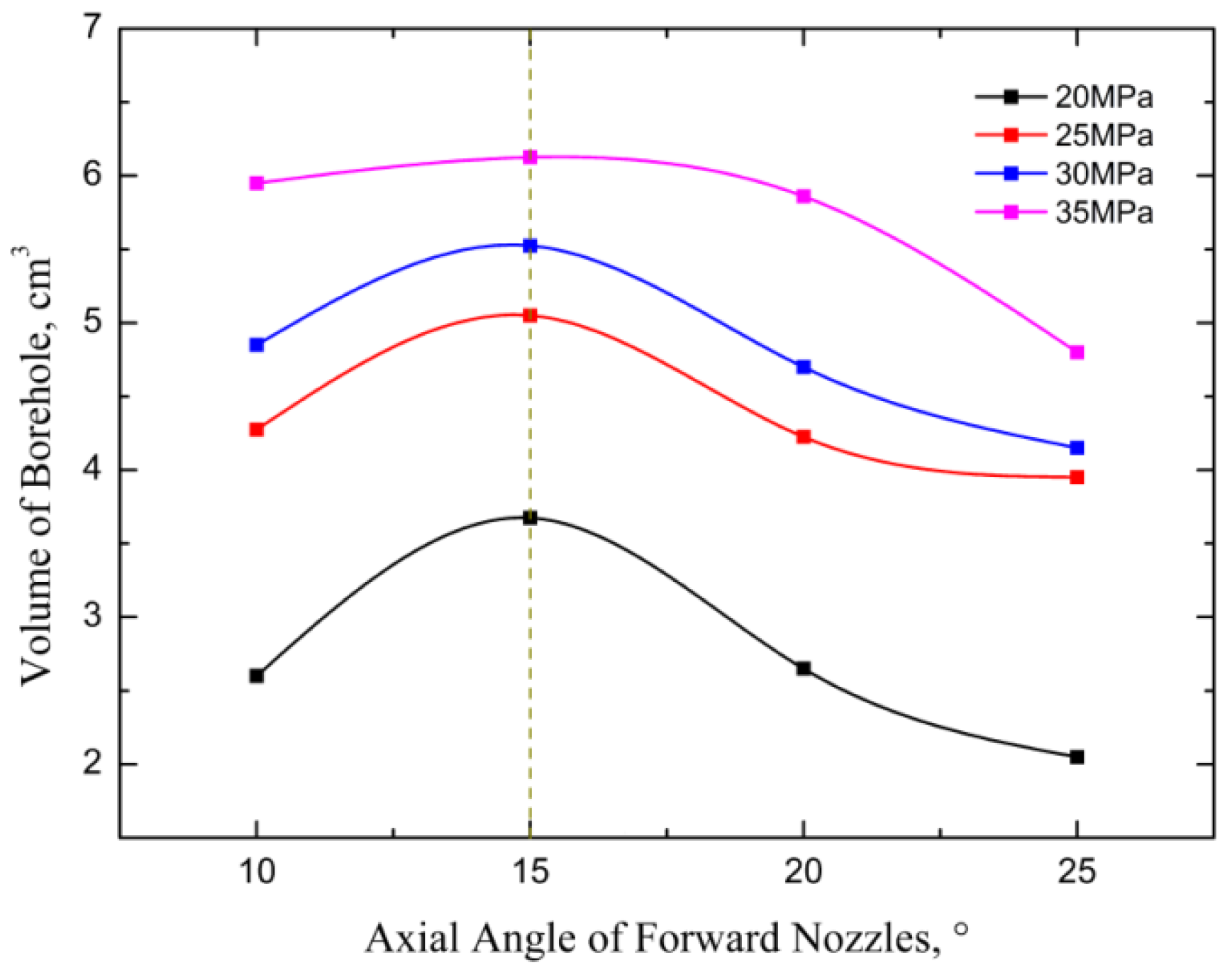
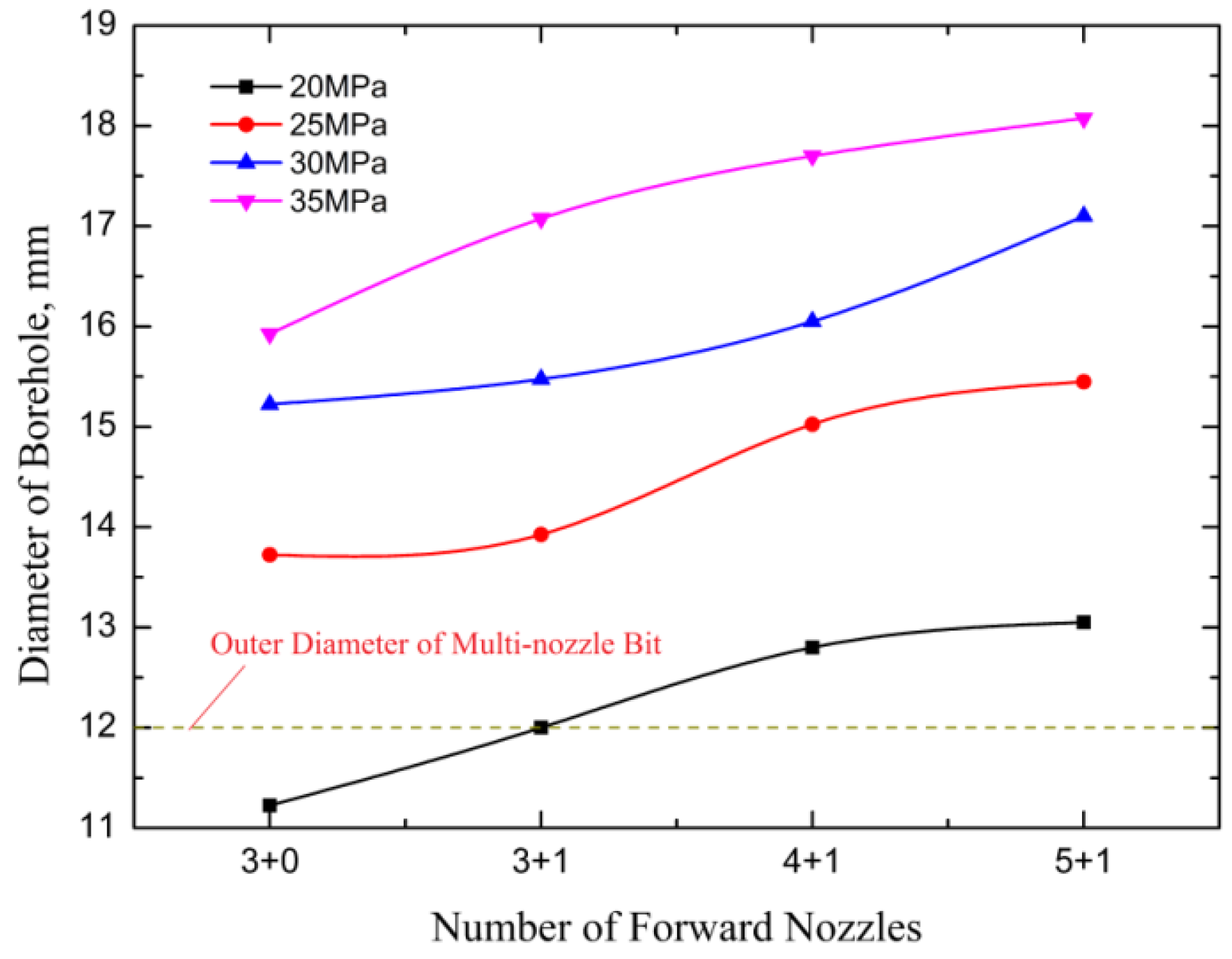

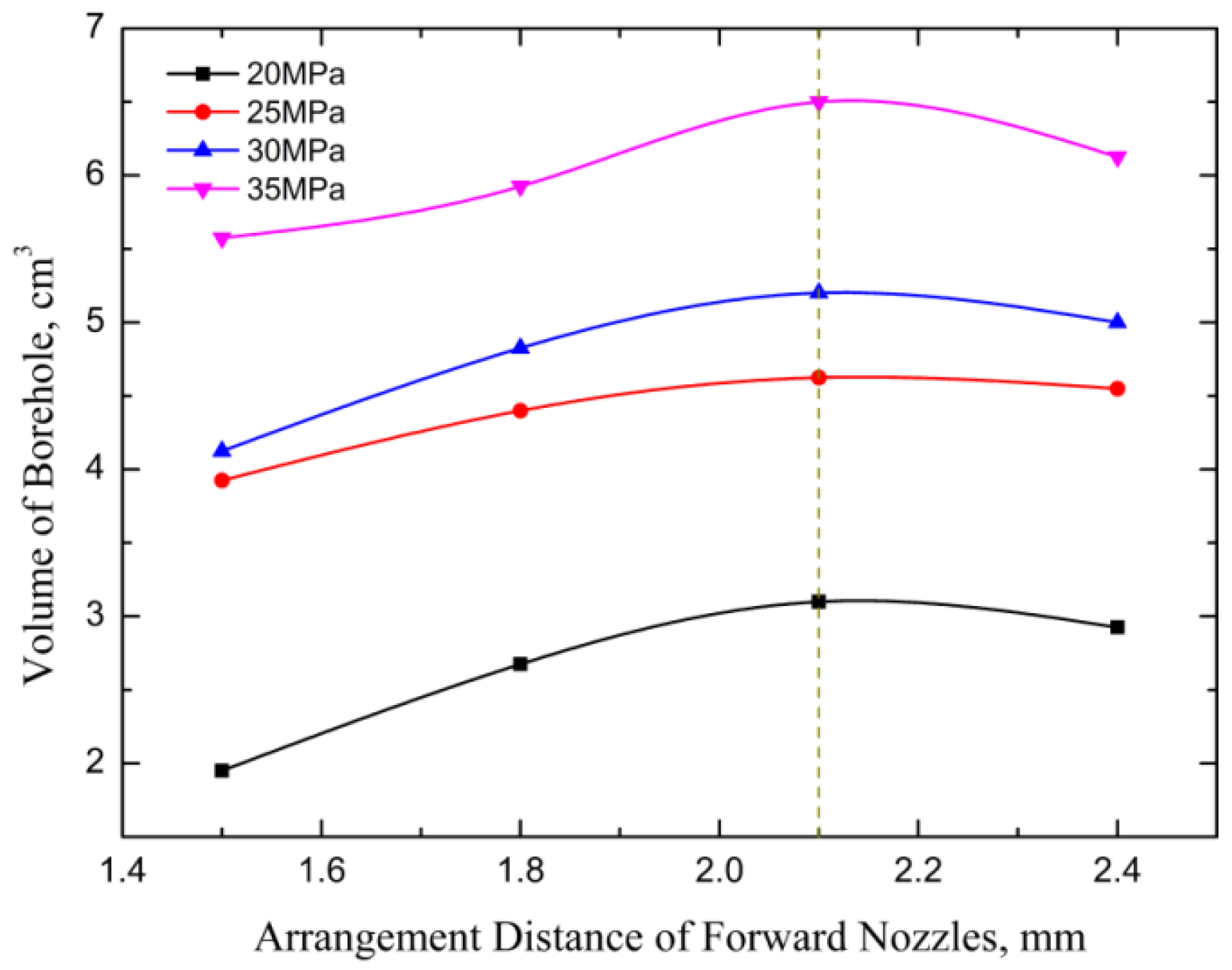
| Levels | Factors | ||||
|---|---|---|---|---|---|
| d0 1/mm | α 2/(°) | β 3/(°) | L 4/mm | nl + nc 5 | |
| 1 | 0.6 | 10 | 0 | 1.5 | 3 + 0 |
| 2 | 0.7 | 15 | 30 | 1.8 | 3 + 1 |
| 3 | 0.8 | 20 | 60 | 2.1 | 4 + 1 |
| 4 | 0.9 | 25 | 90 | 2.4 | 5 + 1 |
| No. | Structural Parameters of Forward Nozzles | Response Values (25 MPa) | ||||||
|---|---|---|---|---|---|---|---|---|
| d0/mm | α/(°) | β/(°) | L/mm | nl + nc | h/mm | D/mm | V/cm3 | |
| 1# | 0.6 | 10 | 0 | 1.5 | 3 + 0 | 24.0 | 9.0 | 1.3 |
| 2# | 0.6 | 15 | 30 | 1.8 | 3 + 1 | 28.0 | 10.9 | 3.1 |
| 3# | 0.6 | 20 | 60 | 2.1 | 4 + 1 | 31.2 | 13.5 | 3.5 |
| 4# | 0.6 | 25 | 90 | 2.4 | 5 + 1 | 29.0 | 14.0 | 4.0 |
| 5# | 0.7 | 10 | 30 | 2.1 | 5 + 1 | 36.5 | 14.8 | 4.4 |
| 6# | 0.7 | 15 | 0 | 2.4 | 4 + 1 | 32.3 | 14.4 | 4.6 |
| 7# | 0.7 | 20 | 90 | 1.5 | 3 + 1 | 31.0 | 12.6 | 4.05 |
| 8# | 0.7 | 25 | 60 | 1.8 | 3 + 0 | 28.0 | 13.6 | 3.35 |
| 9# | 0.8 | 10 | 60 | 2.4 | 3 + 1 | 34.8 | 15.6 | 4.7 |
| 10# | 0.8 | 15 | 90 | 2.1 | 3 + 0 | 33.5 | 15.0 | 6.0 |
| 11# | 0.8 | 20 | 0 | 1.8 | 5 + 1 | 31.0 | 15.7 | 4.4 |
| 12# | 0.8 | 25 | 30 | 1.5 | 4 + 1 | 29.4 | 16.0 | 3.8 |
| 13# | 0.9 | 10 | 90 | 1.8 | 4 + 1 | 36.0 | 16.2 | 6.3 |
| 14# | 0.9 | 15 | 60 | 1.5 | 5 + 1 | 35.0 | 17.3 | 6.1 |
| 15# | 0.9 | 20 | 30 | 2.4 | 3 + 0 | 31.0 | 17.3 | 4.5 |
| 16# | 0.9 | 25 | 0 | 2.1 | 3 + 1 | 28.0 | 16.6 | 4.2 |
© 2016 by the authors; licensee MDPI, Basel, Switzerland. This article is an open access article distributed under the terms and conditions of the Creative Commons by Attribution (CC-BY) license (http://creativecommons.org/licenses/by/4.0/).
Share and Cite
Lu, Y.; Xiao, S.; Ge, Z.; Zhou, Z.; Deng, K. Rock-Breaking Properties of Multi-Nozzle Bits for Tree-Type Drilling in Underground Coal Mines. Energies 2016, 9, 249. https://doi.org/10.3390/en9040249
Lu Y, Xiao S, Ge Z, Zhou Z, Deng K. Rock-Breaking Properties of Multi-Nozzle Bits for Tree-Type Drilling in Underground Coal Mines. Energies. 2016; 9(4):249. https://doi.org/10.3390/en9040249
Chicago/Turabian StyleLu, Yiyu, Songqiang Xiao, Zhaolong Ge, Zhe Zhou, and Kai Deng. 2016. "Rock-Breaking Properties of Multi-Nozzle Bits for Tree-Type Drilling in Underground Coal Mines" Energies 9, no. 4: 249. https://doi.org/10.3390/en9040249






